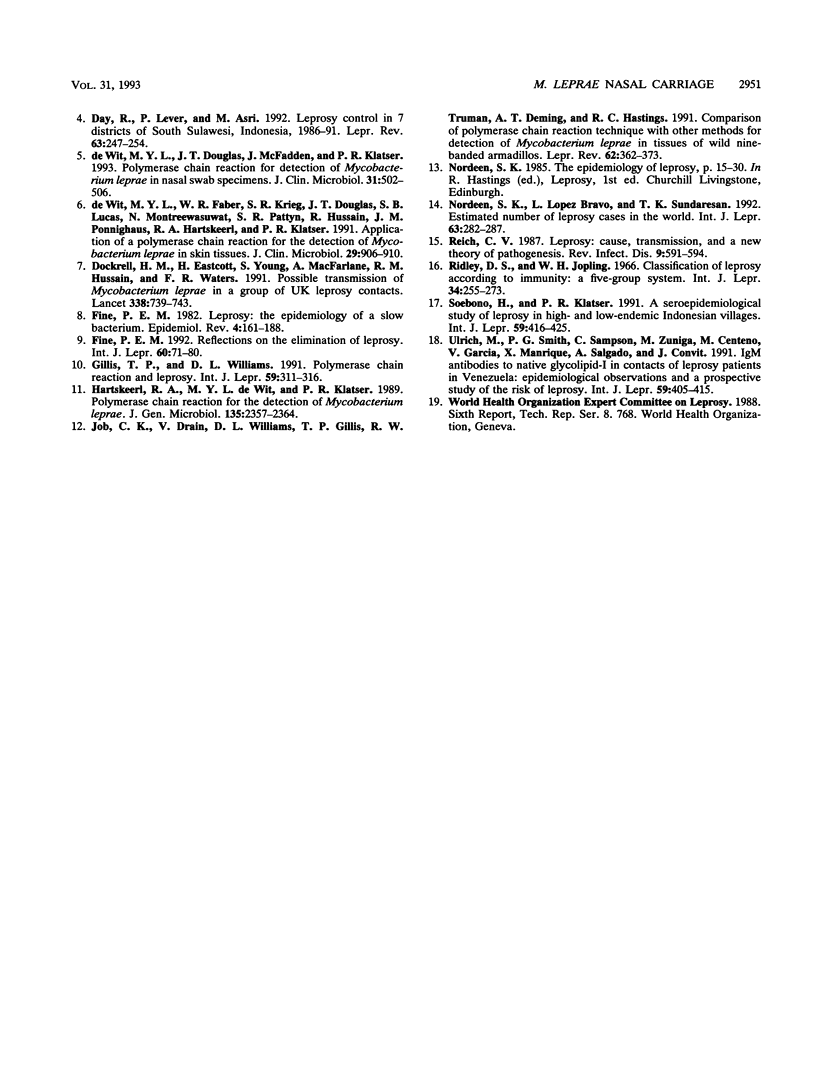Abstract
In order to better understand the role of Mycobacterium leprae nasal carriage in the maintenance of infection reservoirs and transmission of leprosy, we applied a polymerase chain reaction (PCR) that detected a 531-bp fragment of the pra gene of M. leprae on nasal swab specimens collected through a total population survey from individuals living in an area in which leprosy is endemic. Among the total tested population of 1,228 people, 7.8% were found to be PCR positive. PCR positivity was shown to be randomly distributed among the population for which leprosy is endemic. No association was observed between PCR positivity, age, or sex. The observed distribution of PCR positivity among households of different sizes confirmed the expected values, with the exception of two households, each with three people with PCR-positive nasal swab specimens. Although nasal carriage does not necessarily imply infection or excretion of bacilli, the finding of nasal carriage supports the theory of a disseminated occurrence of M. leprae in populations for which leprosy is endemic.
Full text
PDF




Selected References
These references are in PubMed. This may not be the complete list of references from this article.
- Bagshawe A. F., Garsia R. J., Baumgart K., Astbury L. IgM serum antibodies to phenolic glycolipid-I and clinical leprosy: two years' observation in a community with hyperendemic leprosy. Int J Lepr Other Mycobact Dis. 1990 Mar;58(1):25–30. [PubMed] [Google Scholar]
- Cho S. N., Kim S. H., Cellona R. V., Chan G. P., Fajardo T. T., Walsh G. P., Kim J. D. Prevalence of IgM antibodies to phenolic glycolipid I among household contacts and controls in Korea and the Philippines. Lepr Rev. 1992 Mar;63(1):12–20. doi: 10.5935/0305-7518.19920003. [DOI] [PubMed] [Google Scholar]
- Davey T. F., Rees R. J. The nasal dicharge in leprosy: clinical and bacteriological aspects. Lepr Rev. 1974 Jun;45(2):121–134. doi: 10.5935/0305-7518.19740014. [DOI] [PubMed] [Google Scholar]
- Day R., Lever P., Asri M. Leprosy control in 7 districts of south Sulawesi, Indonesia, 1986-91. Lepr Rev. 1992 Sep;63(3):247–254. doi: 10.5935/0305-7518.19920029. [DOI] [PubMed] [Google Scholar]
- Dockrell H. M., Eastcott H., Young S., MacFarlane A., Hussain R., Waters M. F. Possible transmission of Mycobacterium leprae in a group of UK leprosy contacts. Lancet. 1991 Sep 21;338(8769):739–743. doi: 10.1016/0140-6736(91)91454-3. [DOI] [PubMed] [Google Scholar]
- Fine P. E. Leprosy: the epidemiology of a slow bacterium. Epidemiol Rev. 1982;4:161–188. doi: 10.1093/oxfordjournals.epirev.a036245. [DOI] [PubMed] [Google Scholar]
- Fine P. E. Reflections on the elimination of leprosy. Int J Lepr Other Mycobact Dis. 1992 Mar;60(1):71–80. [PubMed] [Google Scholar]
- Gillis T. P., Williams D. L. Polymerase chain reaction and leprosy. Int J Lepr Other Mycobact Dis. 1991 Jun;59(2):311–316. [PubMed] [Google Scholar]
- Hartskeerl R. A., de Wit M. Y., Klatser P. R. Polymerase chain reaction for the detection of Mycobacterium leprae. J Gen Microbiol. 1989 Sep;135(9):2357–2364. doi: 10.1099/00221287-135-9-2357. [DOI] [PubMed] [Google Scholar]
- Job C. K., Drain V., Williams D. L., Gillis T. P., Truman R. W., Sanchez R. M., Deming A. T., Hastings R. C. Comparison of polymerase chain reaction technique with other methods for detection of Mycobacterium leprae in tissues of wild nine-banded armadillos. Lepr Rev. 1991 Dec;62(4):362–373. doi: 10.5935/0305-7518.19910042. [DOI] [PubMed] [Google Scholar]
- Noordeen S. K., Lopez Bravo L., Sundaresan T. K. Estimated number of leprosy cases in the world. Lepr Rev. 1992 Sep;63(3):282–287. [PubMed] [Google Scholar]
- Reich C. V. Leprosy: cause, transmission, and a new theory of pathogenesis. Rev Infect Dis. 1987 May-Jun;9(3):590–594. doi: 10.1093/clinids/9.3.590. [DOI] [PubMed] [Google Scholar]
- Ridley D. S., Jopling W. H. Classification of leprosy according to immunity. A five-group system. Int J Lepr Other Mycobact Dis. 1966 Jul-Sep;34(3):255–273. [PubMed] [Google Scholar]
- Ulrich M., Smith P. G., Sampson C., Zuniga M., Centeno M., Garcia V., Manrique X., Salgado A., Convit J. IgM antibodies to native phenolic glycolipid-I in contacts of leprosy patients in Venezuela: epidemiological observations and a prospective study of the risk of leprosy. Int J Lepr Other Mycobact Dis. 1991 Sep;59(3):405–415. [PubMed] [Google Scholar]
- de Wit M. Y., Douglas J. T., McFadden J., Klatser P. R. Polymerase chain reaction for detection of Mycobacterium leprae in nasal swab specimens. J Clin Microbiol. 1993 Mar;31(3):502–506. doi: 10.1128/jcm.31.3.502-506.1993. [DOI] [PMC free article] [PubMed] [Google Scholar]
- de Wit M. Y., Faber W. R., Krieg S. R., Douglas J. T., Lucas S. B., Montreewasuwat N., Pattyn S. R., Hussain R., Ponnighaus J. M., Hartskeerl R. A. Application of a polymerase chain reaction for the detection of Mycobacterium leprae in skin tissues. J Clin Microbiol. 1991 May;29(5):906–910. doi: 10.1128/jcm.29.5.906-910.1991. [DOI] [PMC free article] [PubMed] [Google Scholar]


